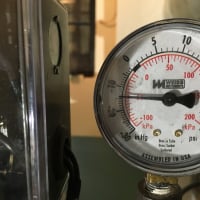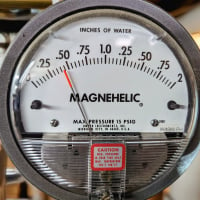Best Of
Re: Semi- temporary heating solution using wood stove and hydronic heat
Water jackets or inside HX are probably gone due to market needs and/ or liability issues. Always protect a HX with a safety relief valve. And dry firing them can lead to a big problem if water hits a red hot device. So a bit more than most people think about. Concept is simple enough, but it needs to have attention to detail.
!/2" copper will not allow much flow, if you use small tube, header it like this.
If you pipe like this, heat output can go directly to the load without need int to heat or travel through the tank.
I'm not sure you need the second tank however, unless you add an element for a second heat option?
My concern is if the stove will be able to keep up with what size load? Make the flow adjustable so you can gauge the heat output to keep the stove from condensing, forming creosote.
A protect valve at the stove hx could be another option, it automatically keeps the stove HX in a safe operating temperature range..
 hot_rod
hot_rod
Re: Vacuum and condensate return opinions
Only if air can flow past water which may not happen at something like the seat of a steam trap.
Re: Vacuum and condensate return opinions
Because that is the pressure seen if there are open vents. If the system is completely closed, it doesn't matter — all you are worried about is absolute pressure differences.
Re: Vacuum and condensate return opinions
Depends on where the "vacuum" is. It helps — a lot — to remember that all one means by the term "vacuum" is the pressure at that location is less than the local pressure of the atmosphere.
And then… water, including condensate, will always flow from a higher pressure to a lower pressure. So there are conditions (almost always misguided piping, or traps in odd places) which can cause lower pressures out in the system somewhere than in the boiler or wherever… and then the condensate will happily flow towards the lower pressure.
Re: Trane Vapor system?
The near boiler piping is awful and nothing close to what the manufactures diagram that is shown in the installation and operation manual . The way it is piped this boiler cannot produce steam as dry as your system deserves to perform properly . Both outlet tapping on the boiler should have been used and the piping should not be copper. If your home comfort advisor didn 't point that out then he is the wrong guy to give advice on a close to 100 year old vapor system . Aside from the near boiler piping being terrible this system should be operated w a vapor stat. The hartford loop nipple should not be long they should have used a street ell. As for where and what to start w i would suggest opening up the check valves on the wet return and flush the mud out of ,next i would open the wet side of the boiler and flush out the mud and muck and rust from the water side of the boiler ,remove and clean the sight glass assemble and clean the low water probe ,the pig tail and piping into the boiler should also be removed and cleaned and flushed .It would also be smart to remove the boilers safety valve and clean it's piping being there usually totally plug thats if ya check it . I would remove the flue collector and open the boiler up and clean the combustion chamber to ensure that it is not full of junk . While your at it have the filter noz and strainer replaced and a combustion test done . A edr of your connected radiator would be a good idea from that you ll be able to determine if the boler is correctly sized and firing the correct gpm for your system . A quick side note is that the trane return trap should have a equalizer line from the steam side of the system and usually they had a vapor vacuum air vent located on the top so as the system cooled it would go into a vacuum and still produce lower temp steam . As for radiator traps from the photo the one looks a bit newer as compared to the original trane trap in the pic.
As a side note steam mains without insulation over heat basements and over time the excessive condensate produced usually starts to grove the bottom of the piping and over time causes leaks at the threaded joints which usually is a semi expensive repair when done w the correct material steel . Insulating steam mains is key to timely steam distribution ,dry steam moves wet steam collapses doing just about zero work and creates vacuum pockets as it does so ,another quick side note is that all of the supply valves if original are usually always a graduated orifice valve ,issue to occur when they have been update to non gradated type valves being orificed valves are hard to locate these days and usally a stanfard valve and a orifice plates are used .
I have a general though that just about everyone who has a two pipe system that's 100 years old would rather give a kidney then replace and update traps to have the system function correctly . i guess there suppose to last forever .Not , and not to point out the completely obvious but zero insulation on steam piping equal a blazing hot basement lack luster steam distribution at the best but one thing for sure is that you shall have high fuel bills and it is not the boilers fault or the building it 's just a lack luster comfort adviser . Personally if i called myself that i would want to be dead it kinda of seems like a carpet bagger term ,i always settle for knuckle dragging piping wrencher who just happens to not be clueless after 40 years of spinning but as its said as long as your comfortable w what there selling then listen .
anyone who states that the boiler is piped correctly and does not need to be re piped according to the manufactures diagrams is not anyone who is really going to bring the system back to the way it was intended to operate and heat the home .A super quick looksee tells me that a proper repipe removing the bull headed tee and installing a proper header using both riser would most likely be out of the $ range most think it will cost ,plus no one will every look at the heating system its the kitchens and bath that get the money being heats used like what 4 months top . Being i always like telling the truth being it does not change much ever in mechanical things possibly look at a big update and switch to hot water or ac and heat system but that's usually even more $ then re piping and repair and insulating . None will say but owning older homes is expensive and finding the right gentlemen to evaluate the system and be honest about it is usually at best difficult being its a hard to be the guy not dilly dallying and telling the truth and being honest about costs will usually lead to not getting the job . A honest contractor might be lured on a time and material over just giving you a wopper of a price being old system things are not usually cut and dry and alot of time is spent just on running the system and seeing where the real issues are and coming up w a game plan . i see the 845 area code which makes sense being the work looks pretty standard for the area being i am the next area code over and see alot of price driven jobs like yours being everybody got eat . I hope non of this seem offensive but i tell it like it is no cotton candy coating
i recently spoke w another contractor and asked how things where going and he stated he knows how actors feel being he does 100 proposals and only gets a bit parts and not the big break lol
peace and good luck clammy
 clammy
clammy
Re: Remembering 911 today
I was standing on the corner of Varick and Watts St when the first plane flew over my head. It struck me what a mechanical sound it was and then I noticed the plane was much lower in the sky than planes typically are. I didn't think much more of it. Not more than 4 or 5 seconds later I heard the crash and looked up and saw the hole in the tower with smoke pouring out of it. There was instant panic around me and a prayer circle seemed to spontaneously form. The Lord's Prayer filled the moment and was interrupted by police shouting unintelligibly into radios. The second plane hit and everyone on the street scattered. No more prayers. No more police. Some people abandoned their cars and ran. I ran into my small 5-unit apartment house to find my friends. They all ran outside to see, then came back in to turn on the news. What was happening?
The scene on the street was indescribable. I was 32 years old and I was terrified. It changed the course of my life. Terror leaves a lasting scar.
Meanwhile, my wife (now ex) and coworkers were advised by security to stay in their building across the street from the towers. No one knew what to tell them to do. When the towers came down they all felt it and heard it but didn't see it. It created more panic. Change of plan. They were hastily told to exit the building and find their ways home. To get everyone out, they were ushered quickly toward large loading dock doors. The doors, now pressed closed with a hill of debris, wouldn't not open. They were trapped in the building surrounded by loud sounds and only emergency lighting.
Finally, we made contact by landline and made a plan to stop trying to stay connected and focus on getting out of Manhattan and get to Staten Island, where I still have family, by boat. When I got across the harbor hours later, a story all its own, she was already there with some of her coworkers and we were both fine.
The day was unimaginable and I am triggered by the concept of all the "Never Forget" stuff we encounter this time of year because if I could, I most certainly would forget. I'd be better off.
 JohnNY
JohnNY
Re: Replacing basement baseboards
check into panel radiators also. They can run on lower SWT, 1/2" tube generally.
 hot_rod
hot_rod
Re: Lukewarm/fluctuating Hot Water with Recirculation Pump
When changing it to pulse, it is going to take 7 days to learn your patterns. For these next 7 days, it will still operate in the pulse mode until it learns so you will not notice any difference for at least a week, so you may need two weeks before the change
 Dave H_2
Dave H_2
Re: Sizing steam radiators
If most of the house has oversized radiators, the room with the correct size is going to be cooler.
If the house has all correct sized and one is oversized the oversized room will tend to be hotter. Especially on cooler days.
If It's a single pipe steam system a TRV and a reasonably sized vent will fix an oversized radiator but not an undersized one vs the rest of the system.
 ChrisJ
ChrisJ
